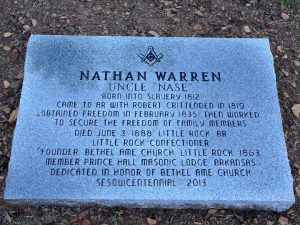by Anne Orsi
The lot of a slave in the American South was not easy, no matter how well he or she was treated by well-intentioned owners. It is hard for many of us to imagine being born into bondage, not free to make our own decisions about where to live, whether to be educated, whom to marry, and whether we can even live with our own families. In the early 1800’s, though, for most black people living in the newly-formed United States of America, such a situation was their reality, and a well-intentioned slave owner was not the norm – certainly not when it came to the liberty of his slaves.
Some slaves overcame their stifling beginnings, though, and became laudable examples of the kind of men and women their entire race should always have been allowed to be. Nathan Warren was one of these great men. Born into slavery, Nathan “Nase” Warren was a successful businessman, a minister, a devoted husband and father, a community organizer, and a civil rights activist. He is buried in a lost grave at Mount Holly Cemetery in Little Rock, Arkansas.
When Robert Crittenden came to Arkansas as the first Secretary of the newly-created Arkansas Territory in 1819, he brought with him a six year old slave called Nase. Some of Crittenden’s white descendants and some of Nathan’s black ones believe Crittenden, who was about 15 or 16 years older than his young slave, was the child’s father.
In 1834, when Nathan was about 21 or 22 years old, Robert Crittenden died nearly bankrupt. Crittenden was only 37 years old when he died, and his widow had difficulty even keeping a roof over her head. This meant turmoil for young Nase, whose ownership was transferred to Daniel Greathouse, the pioneer in Faulkner County, Arkansas, who at the time was living in Little Rock. But Greathouse filed an interesting document with the Pulaski County Clerk – after three and a half years of service, Nase was to be freed. Greathouse died before those three and a half years had expired, and Nase was indeed given his freedom just before Arkansas became the 25th state to be admitted to the Union.
Possibly because of his visibility in the Crittenden household, Nathan had made important contacts among other members of Arkansas’ territorial elite. Chester Ashley, one of the men who donated the land where the Mount Holly Cemetery sits to the City of Little Rock, was one of those contacts. Ashley hired Nathan as a carriage driver. Nathan and Anne, the quadroon daughter of the Ashleys’ cook, married. They would have either nine or ten children together, and Nase would help to rear Anne’s older son, W.A. Rector.
Nase was much more than an ordinary carriage driver. When he took over a confectionery two blocks from the Ashley home, on the land where part of the Capital Hotel now stands, the people of Little Rock quickly learned that he had a true gift for his craft. His shop was so successful that the ladies of Little Rock would not consider having a party without treats from his store. They begged “Uncle Nase” for his secrets, but he refused, telling them that if he shared his recipes with white ladies, he would give away his trade.
His confectionery eventually moved to a larger storefront west of Main Street. He suffered a setback when his shop burned. Arson was suspected. He reopened, though, and business continued briskly.
Nathan was not the only member of his family to live free in the early 1800’s. One of his brothers who had remained with the Crittenden family in D.C. had also been freed, and together they purchased the freedom of a third brother from the Crittenden family in 1844.
When Nathan’s first wife died, he married another Ashley slave, Mary Elizabeth. He had two daughters with her, and eventually purchased their freedom. The children from his first marriage remained slaves in the Ashley family, though.
In the 1850’s, sentiments against free black people ran high in southern states, and Arkansas was no exception. In 1859, Governor Elias N. Conway signed the Free Negro Expulsion Act. Free black people, which meant anyone who had at least one black grandparent, were required to leave the state by January 1, 1860, or face sale into slavery for a period of one year. The continued freedom of about 700 people was directly jeopardized by this Act. Nathan was not among them, though. He was a very intelligent man, and when a similar measure had narrowly failed in the legislature in 1857, Nathan had seen the writing on the wall. He packed up Mary Eliza and their two free daughters and left for Xenia, Ohio, where he lived for several years. While he was in Ohio, he took the name Warren as a surname. At the time of the 1860 census, he lived in Xenia, Greene County, Ohio, with Mary Eliza, their daughters Ellen (8) and Ida (4), and two sons, William (2) and Edwin (7 months). As he had in Little Rock, Nathan worked as a baker.
A story in a newspaper article about Nathan claimed that an old friend encountered him in New York during his exile and that Nathan was miserably unhappy and down on his luck. The friend, a Mr. Tucker, brought Nathan back to Arkansas even though the Act expelling free black people was still in effect. Family legends and the census locating Nathan’s family in Ohio for this time period dispute this version of events. Nathan’s descendants believe that Nathan and his free family returned to Little Rock about 1863, possibly with the help or sponsorship of the Ashley family. Since Nathan had left nine or ten of his still-enslaved children in Little Rock, one can only assume that he missed them and worried about them as the Civil War raged in and around Little Rock. Perhaps local people had their hands full with politics and the war, or perhaps “Uncle Nase” was so well-liked that the society ladies were grateful for his return and persuaded their husbands to leave him alone. At any rate, upon his return to Little Rock, Nathan Warren re-established his confectionery and his popularity.
While living in Ohio, Nathan and the Warren family had been introduced to the African Methodist Episcopal Church. The AME church had broken away from the Methodist Church in Pennsylvania because black congregants wanted their own place of worship, independent from the white church. Almost as soon as he returned from Ohio, Nathan started the Bethel AME Church in Little Rock and was ordained as a minister. The Bethel AME Church is still a vital part of the downtown community, although it has moved into a different building that takes up the block bordered by 16th Street and Wright Avenue between Izard and State Streets. It is celebrating its sesquicentennial this year.
The year Nathan Warren started Bethel AME Church was a turning point not just in his life, but in the lives of all American slaves in rebellious states. The Emancipation Proclamation had been issued on January 1 of that year, and the Civil War raged across the country. Most of the battles fought in Arkansas occurred after January 1863, including the battles of Bayou Meto (also known as Reed’s Bridge) and Bayou Fourche, both of which were fought on the Union army’s approach to Little Rock.
With Lee’s surrender at Appomattox, the rest of Nathan Warren’s family soon became free. Most of the children from his first marriage were adults now, and many of those ten children had inherited Nathan’s musical talent. Nathan was a popular fiddler, and his children played other instruments and performed publicly as a group.
The end of the war brought other changes, too. The government’s efforts at reconstruction in the southern states meant that black people would be granted rights. Exactly how those rights would be realized and exactly how the former slaves would support themselves was uncertain. Nathan Warren was a Pulaski County delegate to the Convention of Colored Citizens held in Little Rock from November 30 – December 2, 1865. It was the first convention ever held by the black residents of Arkansas.
The language contained in the minutes of that convention is stirring. The convention
met for the purpose of conferring with each other, as to our best interest and future prosperity; also, to memorialize the State Legislature and Congress of the United States, to grant us equality before the law, and the right of suffrage, … we have earned it and, therefore, we deserve it; we have bought it with our blood, and, therefore, it is of priceless value to us.
Rev. Nathan Warren delivered the prayer at the closing session on the final day of the convention. The final resolutions of the convention underscored the great hope that the newly emancipated black Arkansans had while recognizing that a struggle still lay before them.
The persecutions of two and a half centuries have not been enabled to destroy our confidence in the eventual justice of the American people. We believe the time has come when wisdom again asserts her sway in the councils of the nation.
It would be another hundred years before the federal government would pass a civil rights act to ensure racial equality.
Through the Reconstruction era, Nathan Warren maintained his confectionery, and his musically gifted children continued performing. Their musical gifts would bring them tragedy, though. In early 1866, the Warren family performers were hired to perform for a private party aboard the steamboat Miami on a journey between Little Rock and Memphis. In the early morning hours of January 28, 1866, the Miami was on its return to Little Rock. As the Miami navigated waters near the then-thriving town of Napoleon in Desha County, where the Arkansas empties into the Mississippi, its boilers exploded. Three of Nathan’s sons, George, Frank, and John, were among the 225 passengers killed, as was his son-in-law, Wash Phillips. Nathan’s son Isaiah and stepson W.A. Rector were on the boat but survived the explosion.
The Miami was one of three such tragedies in just a few days on America’s central waterways. Two days after the Miami’s explosion, the Missouri exploded, and two days after that, the W.R. Carter blew up. Around 365 lives were lost in the three explosions. The causes of the explosions on the Missouri and the W.R. Carter were never explained, but according to a report in the Cincinnati Enquirer on February 6, 1866, inspectors investigating the incident blamed the Miami tragedy on its engineers, who apparently were aware that the boilers needed repairs, but failed to maintain them properly during the trip. The Atlantic and Mississippi Company, which owned all three steamboats and three others that had exploded in the preceding year, had no insurance coverage for its vessels. The Cincinnati Enquirer reported that the company’s managers had reasoned that it was cheaper to replace a boat now and then than it was to pay expensive insurance premiums on its entire fleet. A month to the day after the Miami tragedy, three more of the Atlantic & Mississippi’s steamboats were destroyed by fire near St. Louis. After losing nine steamboats – six within thirty days of each other – the company finally elected to insure its fleet. The Miami was lost during the most destructive four months in the history of America’s river navigation. It was one of twenty-nine steamboats destroyed by fire in the sixteen weeks between December 15, 1865, and April 12, 1866.
Despite this incredible personal tragedy, Nathan Warren continued to push for his own prosperity and for the prosperity of his race. Bethel AME Church grew exponentially, and Rev. Warren himself shepherded the flock there. On August 22, 1873, an article in the Arkansas Gazette described efforts to form an organization designed to test the limits of the newly enacted Arkansas Civil Rights Law of 1873. Some believed the act was a sham and that the white people of Arkansas had no intention of granting rights to black people. Nevertheless, a coalition of black and white citizens met to devise ways in which the law’s purpose could be tested and fulfilled. Rev. Warren attended and was elected to the group’s finance committee.
Rev. Warren’s name appears in minutes of other meetings during Reconstruction. He was a civic leader, a minister, a successful businessman, and a civil rights activist. Despite periods of great suffering, tragic setbacks, and loss, Nathan Warren persevered. His descendants have every reason to be very proud of their notable ancestor.
He died in 1888 at about the age of 76. He was a member of the Mosaic Templars and was accorded Masonic rites at his funeral. He was buried at Mount Holly Cemetery.
Nathan Warren’s tragedies did not end with his death, however. The civil rights he wanted so much for himself and his family were to be tested in the fires of Jim Crow, and at some point during those terrible years of racial inequity, tombstones of the graves of a number of black residents at Mount Holly were vandalized and removed. The minutes of the Mount Holly Cemetery Association are incomplete for dozens of years in the first half of the 20th century, and no one now alive has any memory of exactly what happened to the obelisk that had been erected on Nathan Warren’s grave. Even the location of his grave has been lost to history.
Next to his daughter Maria Rebecca Craigen, whose first husband, Wash Phillips, was killed in the explosion of the Miami, is an empty space suitable for the erection of a replacement monument for Nathan Warren. Mount Holly hopes that, eventually, that space can be filled with a fitting stone for a man who worked so hard against all odds for himself, his family, and his community.

Information for this article was gleaned from two articles by Margaret Smith Ross published in the Arkansas Gazette and in the Historic Arkansas Quarterly, from records compiled by Tom Dillard and stored at the Arkansas Studies Institute’s Butler Center, from Bethel AME Church, and from online resources through the magic of Google. The author wishes to give special thanks to Nathan Warren’s 4th great-granddaughter, Shareese Kondo, for her gracious gift of time and for her family legends about her illustrious ancestor.



